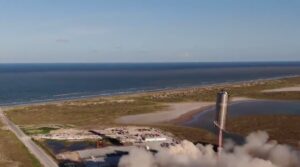SpaceX Starship prototype finally flies
By Jeff Foust

WASHINGTON — After months of delays and testing setbacks, a prototype of SpaceX’s Starship next-generation reusable launch vehicle made a brief “hop” flight Aug. 4 at the company’s South Texas test site.
The Starship SN5 vehicle, powered by a single Raptor engine, lifted off shortly before 8 p.m. Eastern at SpaceX’s site in Boca Chica, Texas. The flight was intended to reach an altitude of 150 meters, although SpaceX did not disclose the exact altitude the vehicle reached.
After flying a short distance sideways, it descended to a landing on a nearby pad about 45 seconds after liftoff. Six landing legs, tucked underneath the skirt surrounding the engine bay, deployed shortly before landing.
Starship takes flight pic.twitter.com/IWvwcA05hl
— SpaceX (@SpaceX) August 5, 2020
The test did appear to have some minor issues. Video of the flight released by SpaceX showed some debris flying off the launch stand after liftoff, while part of the Raptor engine appeared to be on fire as the vehicle descended. Neither appeared to affect the flight of the vehicle.
SpaceX Chief Executive Elon Musk was pleased with the test. “Mars is looking real,” he wrote in a series of tweets shortly after the flight, referring to his long-term goal of going to Mars to make humanity multiplanetary. “Progress is accelerating.”
However, this test flight is months behind a schedule Musk set last September. “This thing is going to take off, fly to 65,000 feet, about 20 kilometers, and come back and land, in about one or two months,” he said at an event at Boca Chica, referring to a prototype known as Mark 1 standing behind him.
That prototype, though, was destroyed in a tanking test last November. Three other Starship prototypes were destroyed in later tests, including the SN4 vehicle that exploded after a static-fire test May 29.
At the event last September, Musk vowed to have reached orbit with the vehicle by now. “This is going to sound totally nuts, but I think we want to try to reach orbit in less than six months,” he said then, a schedule he thought to be “accurate to within a few months.”
Around the time of that event, SpaceX was facing criticism from NASA for appearing to devote more attention to Starship than its Crew Dragon commercial crew vehicle, which the agency was counting on SpaceX to complete to enable the return of human orbital spaceflight to the United States.
NASA Administrator Jim Bridenstine, in a tweet the day before that event last September, expressed his concerns bluntly. “Commercial Crew is years behind schedule. NASA expects to see the same level of enthusiasm focused on the investments of the American taxpayer. It’s time to deliver.”
SpaceX did deliver with the Demo-2 mission, which successfully flew two NASA astronauts to the International Space Station and returned them to Earth Aug. 2 after a two-month mission. Bridenstine said he was pleased, recalling those earlier comments.
“I want to tell you, Elon, you responded absolutely magnificently,” Bridenstine said at an Aug. 2 ceremony at Ellington Field, near the Johnson Space Center, to welcome back the astronauts. “You have delivered beyond anything any of us would have expected.”
Musk was at the same event, calling the successful Demo-2 flight the beginning of a “new era in space exploration” that included going to the moon and Mars. “We’re going to go the moon. We’re going to have a base on the moon. We’re going to send people to Mars and make life multiplanetary,” he said.
SpaceX hasn’t disclosed details about upcoming tests, although Federal Aviation Administration temporary flight restrictions to support hop tests remain in place through Aug. 6. “We’ll do several short hops to smooth out launch process, then go high altitude with body flaps,” Musk tweeted.
August 5, 2020 at 03:47PM
via SpaceNews read more...

Post a Comment